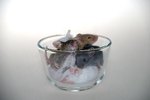
Rodents run the gamut when it comes to their interactions with other members of their species. Many hamsters are independent in nature, such as the Syrian variety. Gerbils, on the other hand, typically thrive on the companionship of others. Mice tend to be in the same camp as gerbils -- social.
Detailed Social Units
Since mice are highly social, they establish detailed and sophisticated units complete with ranking systems. Many factors can affect the place of an individual mouse within the system, including sex, age and breeding status. These "totem poles" often are beneficial for curbing harmful interactions between mice. If the mice are all aware of their social status, they don't usually have to fight for dominance.
Togetherness and Mice in General
Mice don't usually like doing things alone. They form deep bonds with some of their favorite fellow mice. They nestle each other in the wintertime to gather warmth. They relax together. They even blow off steam and play together. Mice utilize high-pitched noises to "speak" to each other, also communicating through scents and touch. Although mice are all about togetherness among themselves, they are usually shy around people.
Traveling Together for Food
If you ever spot a mouse scampering, there's a good chance a few of his buddies are waiting for him not too far away. Mice aren't usually heavy-duty travelers, but when they move around in search of food, they're typically not alone. They stick to small stomping grounds, usually about 30 feet in diameter. They typically scurry around their chosen areas in search of food at night rather than braving daylight. When mice move away from their home locations, it's usually because food is no longer easily accessible.
Traveling for Nesting Sites
Mouse travel isn't limited to searching for food. They also travel to find nests. When they look for nesting sites, they seek out quiet spots that don't receive much or any human traffic, frequently in basements, attics and crawl spaces. Openings in the wall are typical spots for mouse nests. Mice often travel looking for suitable nesting spots in groups, but the females typically handle nest construction on their own.
Youngsters Traveling
Mother mice nurture their offspring for about 21 days. When the little ones are this age, they're usually old enough to travel away from their mothers' turfs on their own to branch out and establish families. Female mice, unlike the boys, typically don't stray too far from their mothers.
Interaction Considerations
Mice often experience intense frustration and unhappiness when they feel deprived of contact with others, even as pets. But their interactions with fellow mice don't always go off without a hitch. Males, for instance, are often extremely fierce around "stranger" mice. As far as successfully living alongside others, female mice tend to work better in that department. Male mice generally do better with other males when they've known each other since birth.
References
- Care Pets Animal Hospital: Small Animal Education
- RSPCA: Mice -- Good Practice for Housing and Care
- Breckland Council: Mouse
- NSW Public Schools: Mice (House Mouse)
- RSPCA: Appropriate Company for Mice
- PETA: Living in Harmony With House Rats and Mice
- Internet Center for Wildlife Damage Management: House Mice
- PETA: Hidden Lives of Rats and Mice
- ASPCA: Mouse Care
- Desert View Animal Hospital: Health Care for Mice and Rats
Resources
Photo Credits
-
BananaStock/BananaStock/Getty Images




